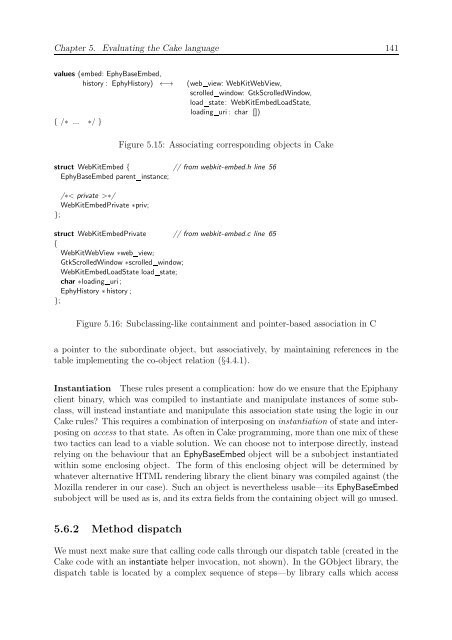Black-box composition of mismatched software components
Black-box composition of mismatched software components
Black-box composition of mismatched software components
Create successful ePaper yourself
Turn your PDF publications into a flip-book with our unique Google optimized e-Paper software.
Chapter 5. Evaluating the Cake language 141<br />
values (embed: EphyBaseEmbed,<br />
history : EphyHistory) ←→<br />
{ /∗ ... ∗/ }<br />
(web view: WebKitWebView,<br />
scrolled window: GtkScrolledWindow,<br />
load state: WebKitEmbedLoadState,<br />
loading uri: char [])<br />
Figure 5.15: Associating corresponding objects in Cake<br />
struct WebKitEmbed { // from webkit-embed.h line 56<br />
EphyBaseEmbed parent instance;<br />
/∗< private >∗/<br />
WebKitEmbedPrivate ∗priv;<br />
};<br />
struct WebKitEmbedPrivate // from webkit-embed.c line 65<br />
{<br />
WebKitWebView ∗web view;<br />
GtkScrolledWindow ∗scrolled window;<br />
WebKitEmbedLoadState load state;<br />
char ∗loading uri;<br />
EphyHistory ∗history;<br />
};<br />
Figure 5.16: Subclassing-like containment and pointer-based association in C<br />
a pointer to the subordinate object, but associatively, by maintaining references in the<br />
table implementing the co-object relation (§4.4.1).<br />
Instantiation These rules present a complication: how do we ensure that the Epiphany<br />
client binary, which was compiled to instantiate and manipulate instances <strong>of</strong> some subclass,<br />
will instead instantiate and manipulate this association state using the logic in our<br />
Cake rules? This requires a combination <strong>of</strong> interposing on instantiation <strong>of</strong> state and interposing<br />
onaccess to that state. As <strong>of</strong>teninCake programming, more thanonemix <strong>of</strong> these<br />
two tactics can lead to a viable solution. We can choose not to interpose directly, instead<br />
relying on the behaviour that an EphyBaseEmbed object will be a subobject instantiated<br />
within some enclosing object. The form <strong>of</strong> this enclosing object will be determined by<br />
whatever alternative HTML rendering library the client binary was compiled against (the<br />
Mozilla renderer in our case). Such an object is nevertheless usable—its EphyBaseEmbed<br />
subobject will be used as is, and its extra fields from the containing object will go unused.<br />
5.6.2 Method dispatch<br />
We must next make sure that calling code calls through our dispatch table (created in the<br />
Cake code with an instantiate helper invocation, not shown). In the GObject library, the<br />
dispatch table is located by a complex sequence <strong>of</strong> steps—by library calls which access
















